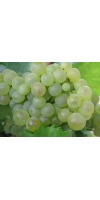Folle Blanche

Folle Blanche is related to Gouais blanc and is also known by the name “Picpoule”. It is however, not related to the Picpoul variety from Languedoc or Gros Plant and Enrageat Blanc. This light skinned grape variety has been mostly substituted with the hybrid Baco blanc because of damage from phylloxera. After the disease ravaged Folle Blanche vines, growers replaced the vincs with the Ugnu-Blanc variety. The Folle Blanche variety is produced in the Loire Valley of France near Nantes to create the wine Gros Plant du Pays Nantis. The Loire Valley region suits almost 8,000 acres of the Folle Blanche variety and it is planted in vineyards throughout France. The strong, dry and acidic wine goes nicely with shellfish. Folle Blanche is also the variety used in Cognac. Folle Blanche works well to create brandy, but because it ripens late in the year and is sensitive to rot and disease, it is not a popular choice for many growers. In the Loire region of France, Folle Blanche is sometimes used to create a varietal wine, but typically Folle Blanche is used to blend with other grape varieties. Folle Blanche produces light, crisp wines that are acidic and it typically generates a large amount of juice. When ripe, the fruit is semi round and is yellowish green in color.
No products found
- back
Selected Options
Grape Types
Categories
Pricing
Countries
Regions
Grape Types
Wineries
Organic/Free Shipping
Rutherford Ranch Reserve Cabernet Sauvignon
Rich and vibrant with classic Rutherford Cabernet tannins, dark cherry mingled with toasty oak, sweet oak and sweet sage lingering on the palate.
The base for our Reserve Cabernet is from the world-renowned Rutherford appellation, which is home to our Abela and Franklin estate vineyards. Perfect climatic conditions and the region’s deep, loamy, well-drained soils produce dark, intensely flavored Cabernet Sauvignon grapes. Our rich soil sets the foundation for an exquisite, cellar-ready wine that will evolve in character and quality for years to come.
This Reserve Cabernet Sauvignon is a beautiful complement to ribeye steak, rack of lamb or mushroom risotto.
Review:
A flint and gunpowder nose leads to bold graphite, blueberry and tobacco flavors in this full-bodied wine that is laced with a high level of fine-grained tannins. This wine is meant for aging, being so tightly packed with fruits and minerals and having the structure to keep it fresh while more complex flavors develop over time. Best from 2028–2038.
-Wine Enthusiast 93 Points
ER3 is the very essence of balance and delicacy – the intensity of Côte des Blancs grand crus and the complexity of its perpetual reserve are combined with immense finesse.
ER3 reveals an extremely delicate, blush pink hue. The nose is superb, with a beautifully complex and delicate aromatic palette that offers up aromas of white flowers, redcurrant, and wild strawberry, before unveiling slightly smoky notes. With a particularly fine and ethereal effervescence, the mouth is fresh and vibrant with superb white fruit and citrus evolving into more complex notes of candied fruit, soft spices, and toasted almonds. The finish is incredibly persistent, underpinned by a magnificent chalky minerality.
The wine is aged on lees in the dark in our cellars for three years.
Chardonnay 75% – Pinot Noir 25% / This edition has been made from a base of the 2018 vintage. / Disgorged in May 2022. / Dosage: 4.5 G/L.
Review:
"This graceful rosé Champagne layers a rich base of roasted almond, toast and smoke accents with nectarine and pureed raspberry fruit, oyster shell, blood orange zest and chalk notes. Fresh and fluid on the palate, with a creamy mousse consisting of fine, pinprick-sized bubbles. Long, rich finish. Chardonnay and Pinot Noir. Drink now through 2030. 750 cases made."
-Wine Spectator 95 Points




